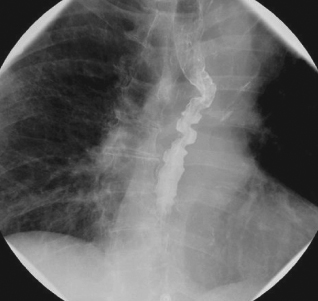Corkscrew Esophagus
Photoclinic
Foresee Your Next Patient
 An 80-year-old woman presented with difficulty in swallowing, which had gradually worsened over 4 weeks. She complained that food was getting stuck and that she frequently had to sit upright to be able to swallow. Sometimes she regurgitated food, which returned into her mouth without any vomitus, sour taste, or bile. This occurred with both solids and liquids. She had no history of similar episodes, chest pain, acid reflux, shortness of breath, nausea, or vomiting. Her medical history included thoracic aortic aneurysm (nonsurgical management), corticosteroid-dependent rheumatoid arthritis (RA), atrial fibrillation, peripheral vascular disease, and chronic obstructive pulmonary disease.
An 80-year-old woman presented with difficulty in swallowing, which had gradually worsened over 4 weeks. She complained that food was getting stuck and that she frequently had to sit upright to be able to swallow. Sometimes she regurgitated food, which returned into her mouth without any vomitus, sour taste, or bile. This occurred with both solids and liquids. She had no history of similar episodes, chest pain, acid reflux, shortness of breath, nausea, or vomiting. Her medical history included thoracic aortic aneurysm (nonsurgical management), corticosteroid-dependent rheumatoid arthritis (RA), atrial fibrillation, peripheral vascular disease, and chronic obstructive pulmonary disease.
Vital signs were normal. She had severe swan neck deformities and ulnar deviation of the hands and feet; these findings were consistent with her history of RA. The remainder of the physical examination results were unremarkable.
An esophagogram revealed advanced tertiary contractions consistent with underlying severe esophageal motility disorder without any reflux.
Diffuse esophageal spasm (DES), or corkscrew esophagus, is part of a group of primary esophageal motility disorders, which can be broadly classified into 3 types:
•DES.
•Hypertensive peristaltic contractions (nutcracker esophagus).
•Hypertensive lower esophageal sphincter (achalasia).
There are no established guidelines for the management of DES. Treatment should be individualized depending on the patient’s symptoms and follow-up. The following agents are used commonly:
• Calcium channel blockers (CCBs): a dihydropyridine CCB, such as nifedipine, or the non-dihydropyridine diltiazem can be used.
• Sublingual nitroglycerin or longer-acting agents, such as isosorbide dinitrate taken orally before meals, can also be used.
• Trazodone and imipramine have been effective in controlled clinical trials in relieving chest pain.1,2
More research is needed to support the following treatments; however, some preliminary studies show benefit:
• Botulinum toxin injection.3
• Phosphodiesterase inhibitors (eg, sildenafil).4
• Bethanechol, which was associated with increased contraction pressures and bolus transit times.5
Diltiazem, 90 mg SR q12h, was prescribed for this patient, and her symptoms greatly improved.
1. Clouse RE, Lustman PJ, Eckert TC, et al. Low-dose trazodone for symptomatic patients with esophageal contraction abnormalities. A double-blind, placebo-controlled trial. Gastroenterology. 1987;92:1027-1036.
2. Cannon RO, Quyyumi AA, Mincemoyer R, et al. Imipramine in patients with chest pain despite normal coronary angiograms. N Engl J Med. 1994;330:1411-1417.
3. Miller LS, Pullela SV, Parkman HP, et al. Treatment of chest pain in patients with noncardiac, nonreflux, nonachalasia spastic esophageal motor disorders using botulinum toxin injection into the gastroesophageal junction. Am J Gastroenterol. 2002;97:1640-1646.
4. Eherer AJ, Schwetz I, Hammer HF, et al. Effect of sildenafil on oesophageal motor function in healthy subjects and patients with oesophageal motor disorders. Gut. 2002;50:758-764.
5. Agrawal A, Hila A, Tutuian R, et al. Bethanechol improves smooth muscle function in patients with severe ineffective esophageal motility. J Clin Gastroenterol. 2007;41:366-370.


